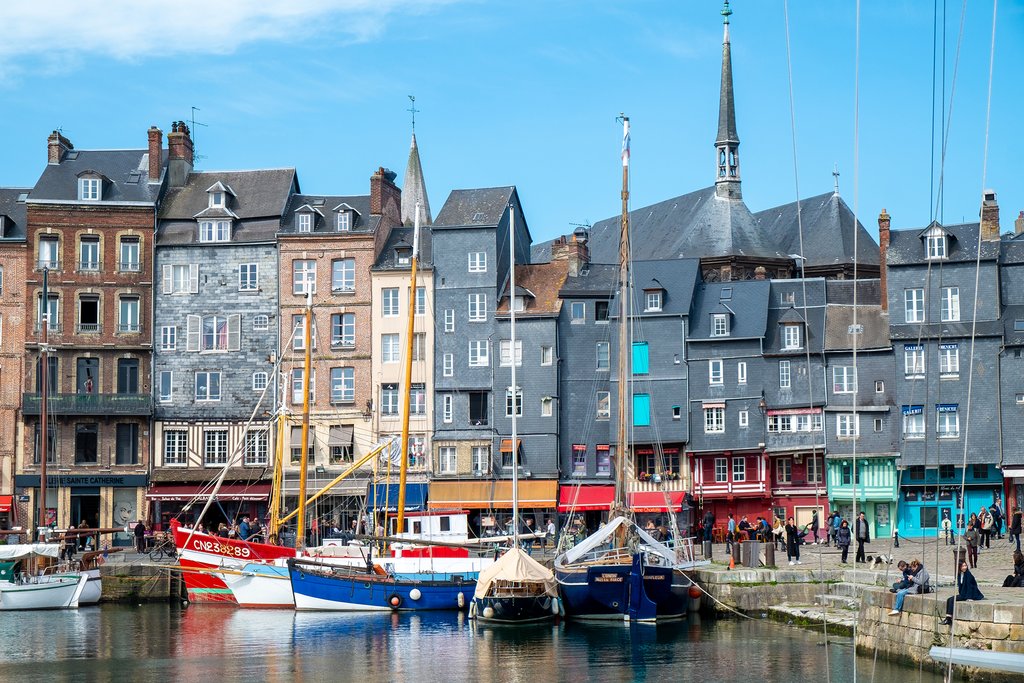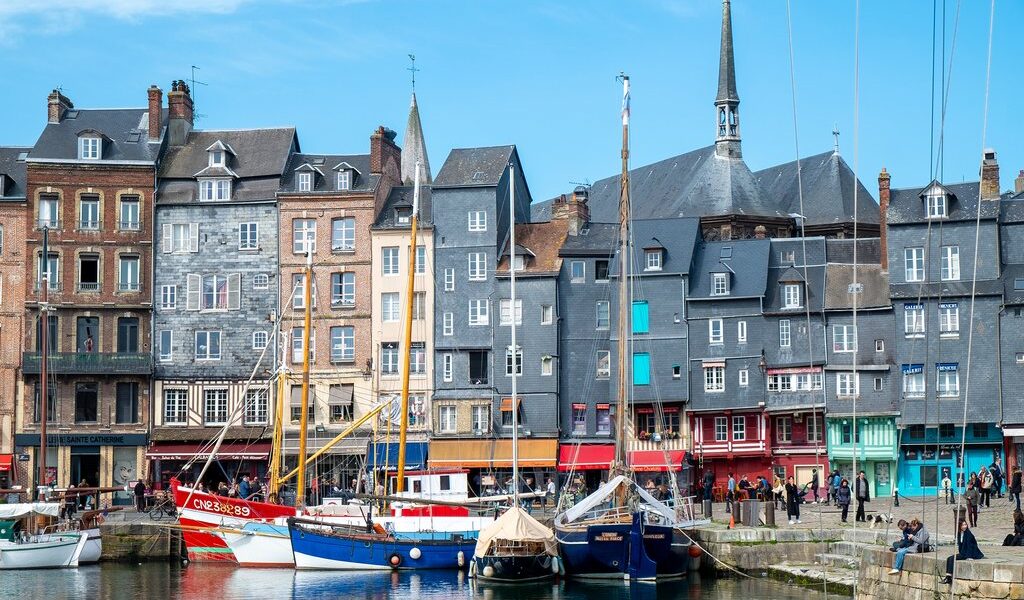
Normandy offers beautiful beaches and mild temperatures, a lovely combination. In spring, especially later in the season, expect beautiful flowers, sunny days, and manageable crowds, making it one of the nicest times to visit. The pleasant summer weather brings big crowds, especially paired with the D-Day commemorations in June, while autumn is rainy and winter is quiet. Read on for advice and information on the best times of the year to visit Normandy.
## Exploring the Enchanting Seasons of Normandy: A Comprehensive Guide
Normandy, a captivating region nestled in northwestern France, offers a unique charm throughout the year. Its location, blessed by the proximity of the Atlantic Ocean, gifts it with a temperate climate characterized by consistent humidity and precipitation. This maritime influence ensures that Normandy experiences cool summers, rainy autumns, mild but often wet winters, and springs bursting with color and life. Preparing for your journey to this historical and picturesque locale requires understanding the nuances of each season.
The summer months of June, July, and August are generally the warmest, though the temperature rarely ventures beyond the pleasant 70s. However, regardless of the time of year you choose to visit, it’s always a good idea to pack layers of clothing and ensure you have reliable rain gear, ready to embrace the unpredictable nature of the Norman climate.
Summer, along with the fringes of late spring and early fall, represents the peak season for tourism in Normandy. During these periods, the region welcomes a significant influx of visitors eager to explore its stunning landscapes and historical landmarks. The crowds swell considerably on summer weekends and particularly in August, as French residents themselves embark on their annual vacations. Arguably, the most bustling period is early June, specifically around the 6th, when the D-Day Anniversary commemorations draw huge numbers of people to Normandy’s iconic beaches. In stark contrast, winter offers a quieter, more contemplative experience, but travelers interested in immersing themselves in the region’s museums should avoid January, as many institutions use this time for their annual closures and maintenance.
## Unveiling the Delights of Normandy in Summer (June – August)
Summer reigns supreme as the peak tourism season, reaching its zenith in August. This period sees an influx of both European and North American tourists, all eager to experience the allure of Normandy. Consequently, major attractions become thronged with visitors, especially during weekends and, most notably, around the annual commemorative events held on the D-Day Beaches in June.
It’s worth noting that August is particularly busy due to domestic tourism. Many French citizens take their vacations during this month, leading to a surge in demand and, consequently, higher hotel prices. To avoid disappointment, booking tours and accommodations well in advance is highly recommended, as the competition for limited spaces intensifies during this period.
Interestingly, despite the summer heat in other parts of France, the Norman coastline maintains a relatively cooler climate. First-time visitors may be pleasantly surprised to find that even in the height of summer, temperatures typically hover around the sixties, occasionally reaching the lower 70s during the warmest hours of the day. Dressing in layers is essential, and a jacket and hat are highly recommended, especially if you plan to spend a significant amount of time exploring the beaches and coastal areas.
Consider complementing your sightseeing adventures with indulging in the region’s exquisite gourmet offerings. Imagine savoring fresh oysters paired with locally produced wine, a truly delightful culinary experience. For an unforgettable journey, explore a luxury trip that expertly blends the highlights of Normandy and Brittany.
### Summer Events
**June 6 – D-Day Anniversary:** Major commemorative events take place annually to mark the anniversary of the 1944 D-Day Landings and the pivotal Battle of Normandy. These events offer a poignant and powerful opportunity to reflect on this significant moment in history.
**July 14 – Fête Nationale:** Known internationally as Bastille Day, this national holiday is celebrated with great enthusiasm throughout France. Expect dazzling fireworks displays and vibrant revelry in towns and cities across Normandy.
## Experiencing Normandy in the Embrace of Fall (September – November)
Autumn in Normandy is characterized as a season of increasing moisture, particularly as October and November approach. Along with higher rainfall, temperatures gradually decline. September often enjoys stretches of sunshine and highs in the sixties, but as the days shorten, expect increased precipitation and average temperatures to settle in the lower 50s and 40s. Packing an umbrella, a reliable rain jacket, and a warm coat is crucial, depending on the specific timing of your visit within the fall season.
However, the willingness to brave the potentially damp weather is rewarded with significantly fewer crowds throughout Normandy during the fall months. This presents a distinct advantage for sightseeing and exploring the region’s renowned cider-producing areas at a more relaxed pace. While September typically offers the best balance of decent weather, fewer crowds, and reasonable hotel rates, the entire fall season provides a unique opportunity to experience a different side of Normandy.
For those traveling with children, a family-friendly trip encompassing Normandy, Brittany, and western France could provide an enriching experience for everyone.
### Fall Events
**September – Normandy Impressionist Festival:** This vibrant festival, a culmination of months-long celebrations, concludes with a series of art-focused parties and captivating special events, showcasing the region’s artistic heritage.
**September 21 & 22 – European Heritage Days:** During these days, historic monuments and buildings throughout Normandy and across Europe open their doors to the public, offering a rare glimpse into the rich history and cultural significance of these sites.
## Discovering the Serene Beauty of Normandy in Winter (December – February)
Winter in Normandy brings a distinct shift in atmosphere, characterized by chilly temperatures and frequent rainfall. December stands out as the region’s rainiest month, while January claims the title of the coldest, with temperatures often hovering in the 30s. Snowfall is infrequent, and when it does occur, it usually manifests as a light dusting that quickly melts into rain. In contrast, February offers a respite from the precipitation, emerging as the driest month of the year in Normandy.
The upside of visiting during winter is the lower hotel rates and the absence of crowds at many tourist sites, particularly those located along the beaches. However, it’s important to acknowledge that many small businesses, including family-run restaurants and shops, often close for the winter season. Additionally, numerous museums may temporarily shut their doors during January. These factors should be carefully considered, depending on your specific interests and desired activities. Nonetheless, winter presents the most budget-friendly opportunity to visit Normandy and guarantees a far less crowded experience.
Consider incorporating Normandy into a longer itinerary across France, encompassing destinations such as Bordeaux, the Loire Valley, and Paris, for a more comprehensive exploration of the country’s diverse offerings.
### Winter Events
**December – January – Christmas & New Year:** Throughout December and into the New Year, festive events blossom across the region, with highlights including a major parade in Rouen and enchanting special lighting displays illuminating the charming smaller villages.
## Welcoming the Renewal of Normandy in Spring (March – June)
Spring in Normandy shares similarities with fall in terms of weather patterns and crowd levels. However, one notable advantage is the reduced rainfall; you can anticipate more sun-drenched days and fewer instances of disruptive rainstorms. The fall and winter precipitation bestows a beautiful reward, with an abundance of flowers blooming across the landscape. Average temperatures in April and May typically settle in the fifties, gradually climbing into the sixties as June approaches. Dressing in layers remains advisable, and the application of sunblock is essential, even on overcast days.
The spring season sees a growing number of international tourists and French weekenders, particularly as temperatures rise. Nonetheless, it provides an excellent opportunity to explore popular destinations such as Mont Saint-Michel, which can become uncomfortably crowded during the summer months. If cost-effectiveness is a primary consideration, consider planning your trip for March or April, before the peak tourist season fully commences and hotel rates begin to increase.
Embark on a five-day itinerary tailored for history enthusiasts and beach lovers, basing yourself in Bayeux and discovering many of the region’s most captivating sights.
### Spring Events
**May – Jazz Sous les Pommiers (Jazz Under the Apple Trees):** A prestigious jazz festival that has been captivating audiences annually for decades.
**May – Mont-Saint-Michel Bay Marathon:** It’s difficult to conceive of a more picturesque and inspiring setting for a marathon than the breathtaking landscape surrounding Mont-Saint-Michel Bay.
## Mastering the Art of Avoiding Crowds During Normandy’s High Season
Choosing the right time to visit can significantly enhance your experience. Opting for a winter visit allows for peaceful exploration of the D-Day beaches and museums, but requires enduring cold weather and rain. Summer promises great weather but comes with the trade-off of substantial crowds, a pattern that extends to many weekends from May to September.
If your visit falls during the warmer months, strategic planning is essential. Reserving hotel rooms and tours well in advance is paramount. Furthermore, embrace an early start to the day; many vacationers don’t book early-morning excursions, so by getting a jump start, you can effectively avoid the busiest times of day, particularly at the D-Day beaches. If you wish to avoid the D-Day commemorations on and around June 6th, plan your trip accordingly to save money and avoid the largest crowds.
Consider exploring the smaller towns and coastal villages of Normandy, often overlooked by the mainstream tourist routes, as they provide an excellent opportunity to escape the crowds.
## Conclusion: Identifying the Ideal Time to Experience Normandy
For those captivated by history, June 6th presents a unique and compelling time to visit Normandy. While the crowds will be substantial and advance booking is essential, the annual D-Day commemorations offer a profound and unforgettable experience. However, if attending this specific event is not a priority, consider scheduling your trip for late May or September, as these months typically offer a favorable balance of pleasant weather, manageable crowds, and affordable hotel rates. July is undoubtedly busy but boasts excellent weather conditions. October through January marks the wettest and chilliest period, while spring, adorned with blooming flowers and sunny skies, presents a delightful opportunity to explore the region.
B-843

